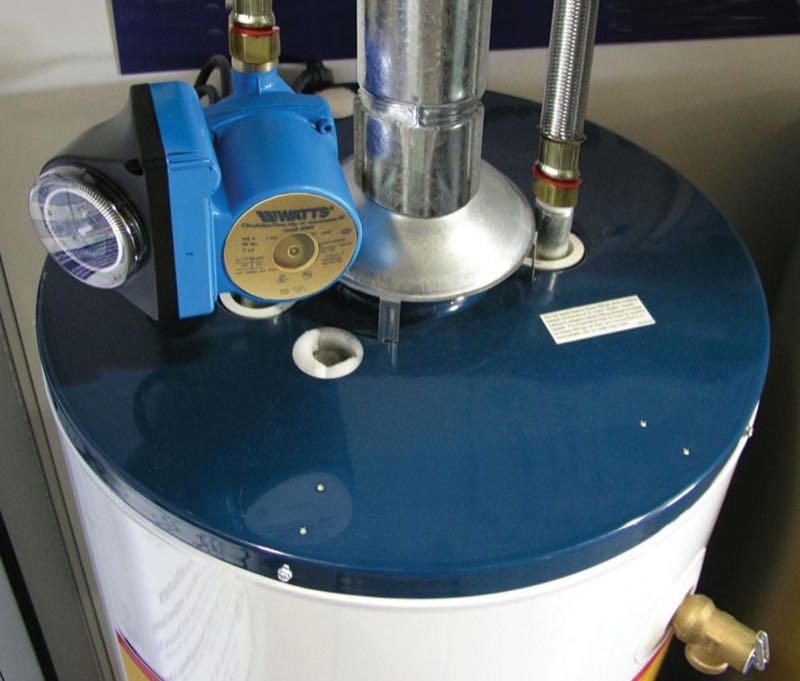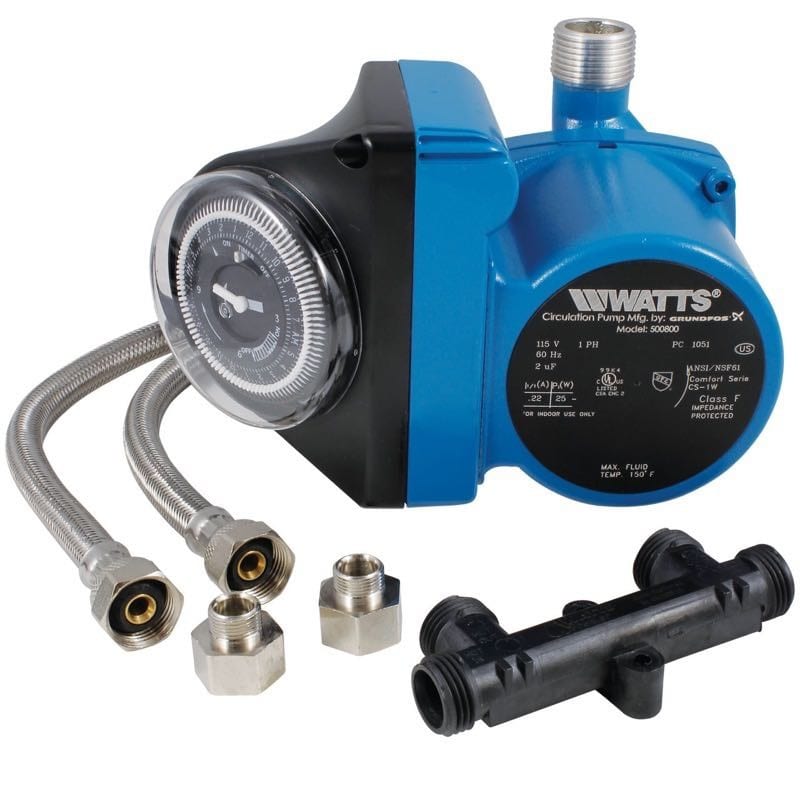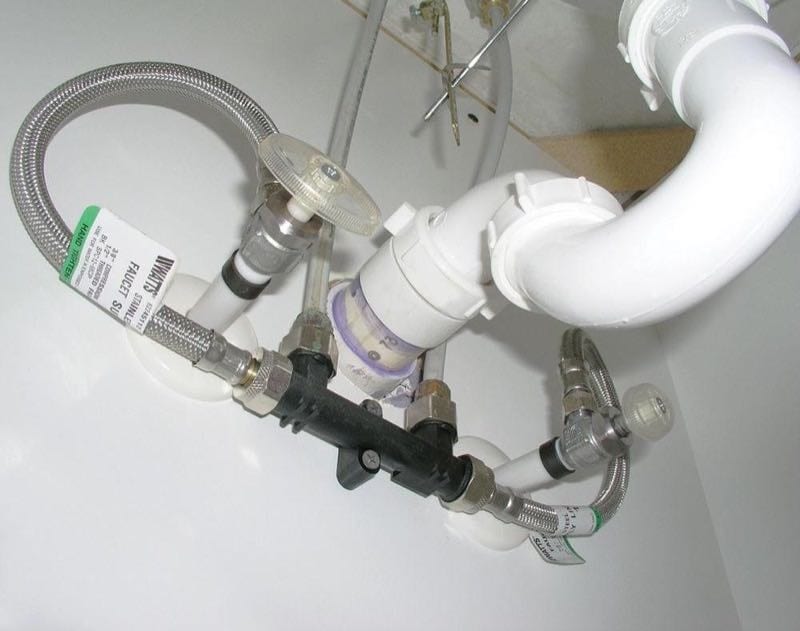We Show You How to Install a Watts Hot Water Recirculating Pump
Do you have to run your faucet in the morning for a few minutes before you get hot water? Those days can be over. You just need to know how to install a hot water recirculating pump. For this low-cost and simple installation, we used a Watts Hot Water Recirculating Pump (model 500-800). This system is well suited for existing homes where it is nearly impossible to run a new hot water recirculation pipe.
We chose this system to be installed in a beach house where they had over 100 feet of piping from the water heater which was located in a small mechanical room below the house to the master bathroom sink faucet on the other side of the house on the second level. To further complicate the plumbing situation at this home, all the main supply piping from the water heater was run underground, then up the side of a 10 ft high wood pier into the home above.
Since there is no way to insulate the piping beneath the concrete slab under the home, there was a tremendous amount of heat loss. This is especially evident after the hot water sat in the pipe overnight. In the morning it would take a least 4 minutes before the water would come out warm from the faucet. We figured this house would be an extreme example of this type of scenario and a great application of a product like the Watts 500800 Hot Water Recirculation System.
How to Install a Watts Hot Water Recirculating Pump
The pump appears to be well made with heavy solid brass pump housing. The pump controls and timer is integrated into the pump assembly. Also included in the box were the bypass valve, two flexible stainless steel sink connection hoses with adapters and the instruction book. For all the various types of plumbing systems out there, you will have to match up your pipe type with a threaded coupler to mate with the pump; these additional fittings were not included in the box.
Using a Watts 500-800 Hot Water Recirculating Pump
We gave the Watts Hot Water Recirculating Pump instruction book a quick read. We wanted to make sure we had all the parts and we understood the concept of the system. For our installation we started at the water heater. We had just swapped out our water heater. Consequently, we had the water heater and piping already drained and ready for the modifications necessary to pipe the pump. The pump is supposed to be installed on the hot water out side of the water heater.
For this installation, we opted to use some dielectric unions between the hot water heater connection and our copper piping. The dielectric union serves two purposes. One, it minimizes the corrosion that often happens when dissimilar metals come in contact with each other. The second benefit of using them is it makes it easy to disassemble the piping from the water heater should that ever be necessary.
Making the Proper Connections
Since our installation involved sweated copper joints, I proceeded to make the proper connections. I ensured the threaded ends of the pump connections would work with the plumbing. The installation of the pump was very straightforward and the directions were easy to follow. For power, we plugged the pump into a nearby GFCI protected receptacle. A 10 foot long power cord came attached to the pump.
Installing the Bypass Valve
The second part of the system is a small plastic bypass valve. This gets installed under the sink that is the farthest away from the hot water heater. First I shut off the water at the valves under the sink. Next I disconnected the supply lines from the valves. I used a single screw to secure the new bypass valve to the wall in between the hot and cold water valves.
Then I proceeded to connect up the piping to the correct points on the valve. There are two sets of connections that were clearly labeled. One set feeds the faucet and one set is where the water supply comes into the valve. The included flexible water lines are designed to connect the bypass valve to the water supply valves. Once all the connections were tight we were finished here.
Now came the moment of truth. Well actually we had to wait for a good couple of hours for the moment of truth. It takes a while for a new water heater to fill up. It also has to heat up the water and distribute it thoughout the system. Once all the air was bled out of the system and water was flowing, we checked for leaks one last time. Finally, we packed up our tools and went home.
The next morning we called the homeowner to see how the water felt first thing in the morning. He said that it only had to run for a few seconds before it was hot. This was a significant improvement. Before, it would need to run for almost 5 minutes for the same effect!
How Does a Hot Water Recirculating Pump Work?
At this point, you are probably wondering how the system works. The key to the Watts 500-800 hot water recirculation pump is in the bypass valve we installed under the sink. As the circulatory pump on the water heater pumps hot water into the line, the bypass valve opens and closed automatically based on the water temperate at in the pipe at the sink.
When the hot water reaches 98 degrees (+/- 5 degrees F) the valve closes. When the temperature falls below this, the valve opens and a small amount of the hot water then circulates into the cold water supply line until the hot water temperature is again brought up to the correct temp. By keeping even a small amount of the hot water flowing back though the system in the cold water line, it ensures you always have hot water available.
It is interesting to note that the cold water at the sink was not as cold as it was before the installation. This was due to the small amount of hot water being introduced into it. The cold water never gets “warm”, though. Also, seconds after turning on the cold water, it flows nice and cold. The controller on the pump has several settings. You can leave the pump on all the time. Alternatively, you can have the timer run the pump only at certain times of the day. This helps when you only require hot water in the mornings or evenings.
How Much Money Will It Cost or Save?
To do a quick check of the potential cost savings let’s take an average home with 125 feet of 3/4-inch pipe. 125 feet of 3/4″ copper pipe holds 3.14 gallons of water.
With 10 draws per day, that wastes almost 31 gallons of water. That assumes the water runs for just one minute while you wait for it to get hot. Over a year, that comes to 11,461 gallons!
a hot water recirculation pump system is not recommended for tankless or instant water heater systems. Those types of systems are based on different methods to heat the water and defeat the purpose.
Conclusion
Having at first been a skeptic, I will have to say I was sold by the low cost. For less than $200, you can get a high-quality, easy-to-install hot water recirculating pump. You can use these pumps for nearly any home where you have to wait for the water to get hot at a distant faucet.




